A list of scary animals for Halloween.
To celebrate Halloween we’ve made a list of some of the world’s scariest animals. Continue reading… if you dare!
Free Printable Halloween Animals Quiz To Download
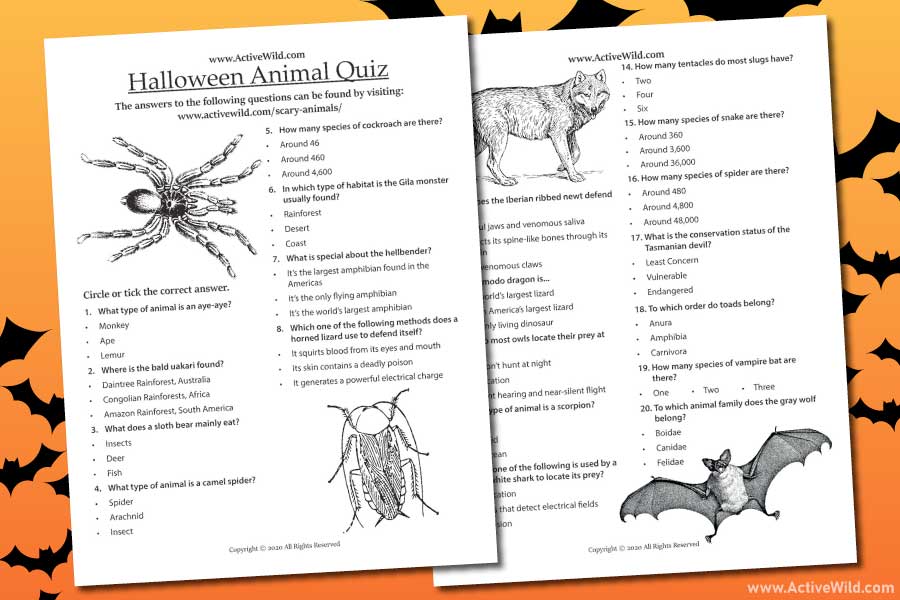
Test your knowledge of dangerous, creepy and scary animals with this FREE quiz!
Click here or on the image above to download your copy. All of the answers can be found on this page!
Below you’ll find mammals that drink blood, reptiles with venomous saliva, birds with terrifying calls, lizards that squirt blood from their eyes, and arachnids with freakishly large mouthparts!
What's your favorite scary animal? Have we missed any out? Let us know in the comments at the bottom of the page!
Scary Animals Page Index
- Aye-Aye
- Bald Uakari
- Bears
- Camel Spiders
- Cockroaches
- Dracula Parrot
- Gila Monster
- Hellbender
- Horned Lizards
- Iberian Ribbed Newt
- Komodo Dragon
- Owls
- Pacific Viperfish
- Scorpions
- Sharks
- Slugs
- Snakes
- Spiders
- Tasmanian Devil
- Thorny Devil
- Toads
- Vampire Bat
- Vampire Squid
- Wolf
- More Animal Facts
Aye-Aye
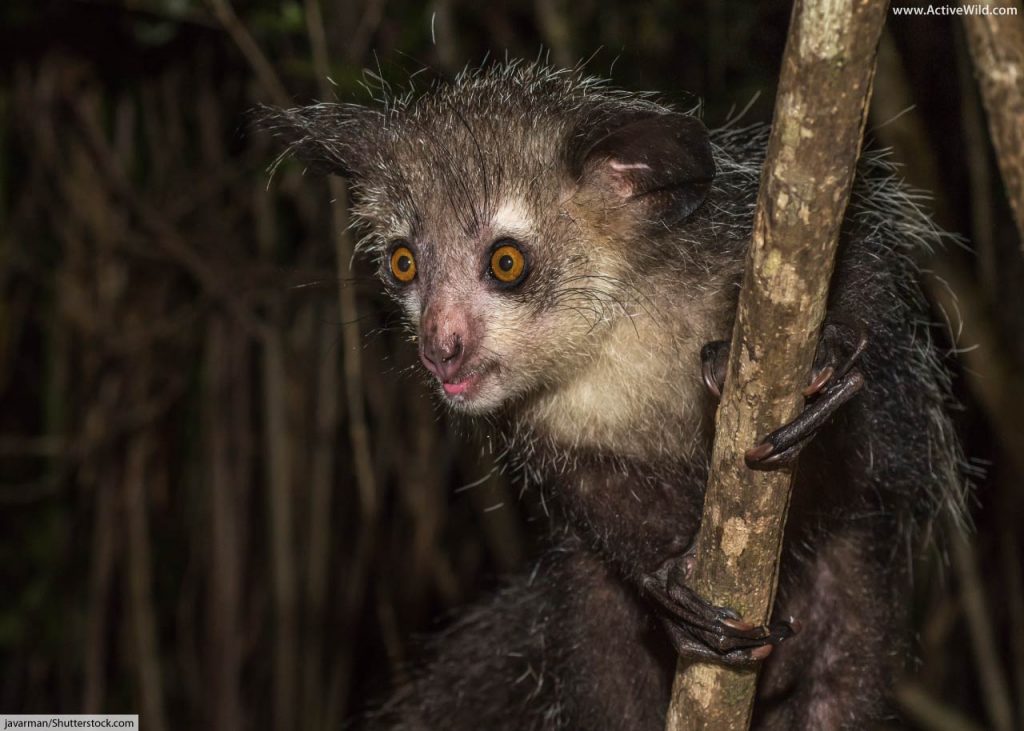
- Scientific name: Daubentonia madagascariensis
- Type of animal: Mammal
- Conservation status: Endangered
The aye-aye is a lemur found on the African island of Madagascar. Local people believe that the aye-aye brings bad luck, especially if it points at you with its skeletal finger (the species uses its elongated middle fingers to prize grubs out of nooks and crannies).
There are around 100 species of lemur. Lemurs are only found on Madagascar, where they evolved independently of other primates such as monkeys and apes. The aye-aye lives in the rainforests on the eastern side of the island.
The aye-aye is the world’s largest nocturnal primate. This endangered animal hunts using echolocation. By tapping on trees, it is able to tell from the sound if food is present under the bark.
- You can find out more about the aye-aye on this page: Aye-Aye Facts
- Discover more rainforest animals on this page: Rainforest Animals List with Pictures & Facts
Bald Uakari
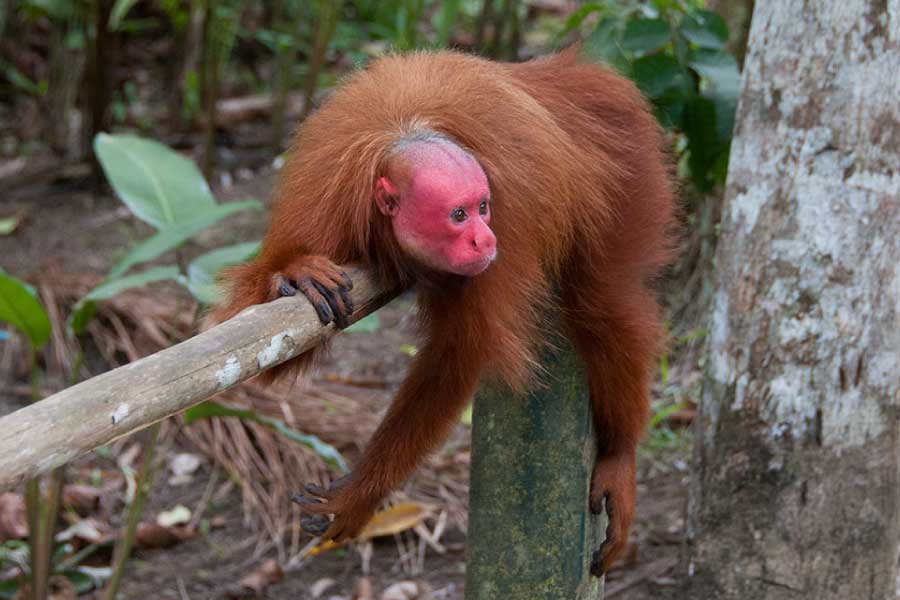
- Scientific name: Cacajao calvus
- Type of animal: Mammal
- Conservation status: Vulnerable
The hairless red head of the bald uakari gives this small monkey an almost human-like appearance. This bizarre-looking primate is found in the western reaches of the Amazon Rainforest in South America.
Sadly, hunting and habitat loss mean that the bald uakari now has a conservation status of ‘Vulnerable’.
- You can find out more about monkeys on this page: Monkeys: The Ultimate Guide
- You can find out more about monkeys in the Amazon Rainforest on this page: Amazon Rainforest Monkeys
Bears

There are only eight living species of bear: polar bear, brown bear, American black bear, spectacled bear, sloth bear, sun bear, Asian black bear and giant panda.
Together these eight species make up the family Ursidae.
Most bears are omnivores, although some, such as the giant panda and spectacled bear, mainly eat plants. The sloth bear is a specialist insect eater.
The polar bear is the most carnivorous of all bears, and on average the largest, although the Kodiak bear (which is a subspecies of brown bear) can be even larger.
They may be cute as cubs, but as adults bears are big, powerful, and well-armed. They’re likely to attack if they think you’re a threat–or, in the case of brown bears and polar bears–if they’re hungry!
The insect-eating sloth bear is surprisingly aggressive given its diet and even the giant panda has been known to attack humans!
Bears make many appearances in myths and legends. Two constellations–Ursa Major (the great bear) and Ursa minor (lesser bear)–are named after bears.
- You can find out more about bears on this page: Bears: The Ultimate Guide
Camel Spider

- Order: Solifugae
- Type of animal: Arachnid
Camel spiders are a group of arachnids that are mostly found in deserts and other arid habitats.
Being arachnids, camel spiders have eight legs, along with two additional pairs of appendages on their heads.
In camel spiders, these additional appendages take the form of long, leg-like feelers, and freakishly large, fearsome-looking mouthparts.
- You can find out more about camel spiders on this page: Camel Spider Facts
Cockroaches

- Type of Animal: Insect
Insects aren’t particularly well-liked animals at the best of times, but cockroaches have a particularly bad reputation.
More “gross animals” than “scary animals”, cockroaches are associated with dirty, unhygienic surroundings. They’re known to transmit disease, and can cause an unpleasant odor in buildings in which they are present.
The German cockroach Blattella germanica is the most commonly-encountered cockroach in the United States. It is one of around 4,600 cockroach species, all of which are members of the order Blattodea.
Cockroaches are closely related to termites, which are also members of Blattodea.
The German cockroach is a survival expert. This hardy insect is found on all continents except Antarctica, and can reproduce faster than any other “pest” cockroach. Some people think that, in the event of a nuclear war, cockroaches would be the only species to survive!
- You can find out more about insects on this page: Insects: The Ultimate Guide
Dracula Parrot

- Scientific name: Psittrichas fulgidus
- Type of animal: Bird
- Conservation status: Vulnerable
Pesquet's parrot has been given the alternative name of "Dracula Parrot" due to its black and red plumage (which resembles the cloak worn by the fictional vampire), large size, featherless face and long bill.
The distinctive parrot's bill and bald face give it a vulture-like appearance, and because of this the species is also known as the vulturine parrot.
The Dracula parrot is found in the mountain forests of New Guinea. Despite its fearsome looks, the species is a frugivore (fruit-eater). Instead of drinking blood, it uses its large, powerful beak to open hard nuts and fruits; its favorite food being figs.
Due to habitat destruction and hunting (for its feathers, which are used in ceremonial dress by indigenous peoples), Pesquet's parrot is rated "Vulnerable" by the IUCN.
- You can find out more about birds on this page: Birds – The Ultimate Guide
Gila Monster
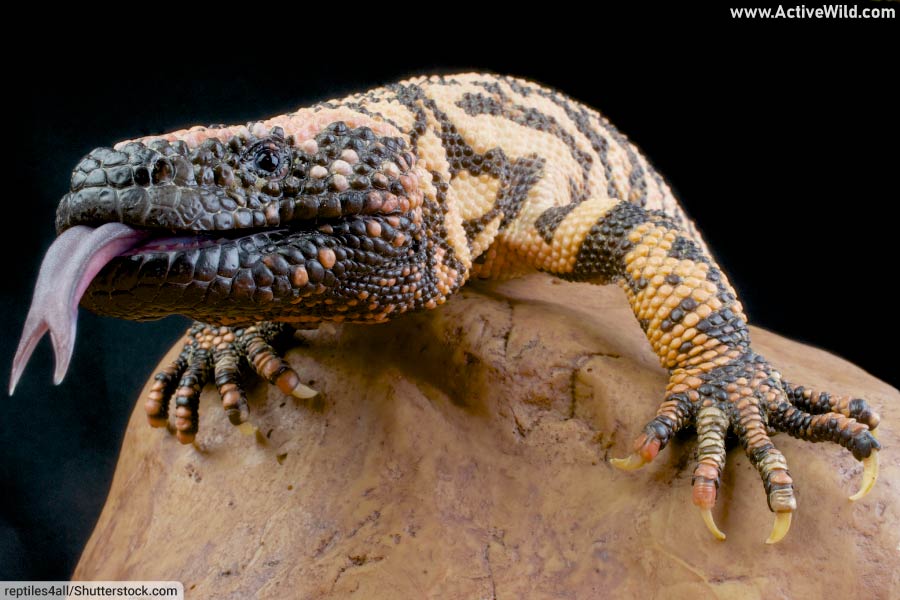
- Scientific name: Heloderma suspectum
- Type of animal: Reptile
- Conservation status: Near Threatened
The Gila monster is one of only two venomous lizards found in North America (the other being the closely-related Mexican beaded lizard). Although the species feeds mainly on eggs, its venom helps it to subdue live prey such as small birds, mammals and reptiles.
The Gila monster's venomous bite, together with its warning coloration, help protect it from predators.
This large, black / orange lizard grows to a maximum length of around 56 cm (22 in). It is found in deserts and scrubland in the southwestern United States and Mexico.
Although the Gila monster had a fearsome reputation among early settlers, its bite, although extremely painful, is rarely fatal.
- You can find out more about the Gila monster on this page: Gila monster facts
Hellbender
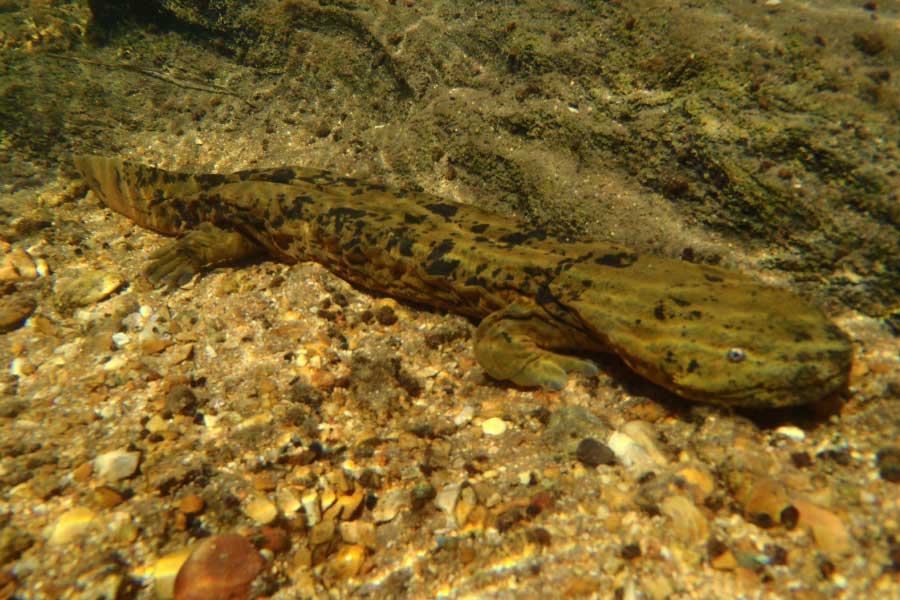
- Scientific name: Cryptobranchus alleganiensis
- Type of animal: Amphibian
- Conservation status: Vulnerable
A true ‘river monster’, the hellbender is one of the largest amphibians in the world, and the largest found in the Americas. The species reaches a maximum length of around 74 cm (29 in).
The hellbender lives in fast-flowing rivers and streams. Unlike most other amphibians, it lives in the water even after having reached maturity. The species is entirely carnivorous, preying on crayfish, mollusks and fish.
Although the hellbender has lungs, it also obtains oxygen from the water via its slimy, wrinkled skin.
- You can find out more about the hellbender on this page: Hellbender Facts
Horned Lizards
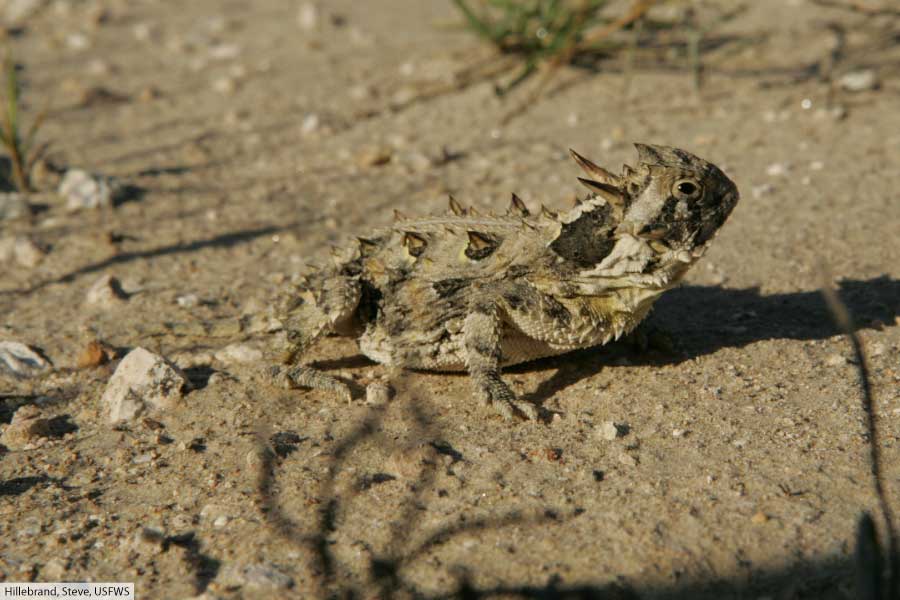
- Type of animal: Reptile
Horned lizards are reptiles in the genus Phrynosoma. With armored plates, rows of spines running along their sides and backs, and horn-like spines on their heads, horned lizards resemble miniature dinosaurs.
Due to their squat, rounded appearance horned lizards are also known as horny toads.
Horned lizards don't tend to move very fast and rely on their excellent camouflage to keep out of the way of predators.
Why are horned lizards included in this list of Halloween animals? It's not their dinosaur-like appearance, but something even more terrifying; when threatened, these little reptiles squirt a stream of blood from their eyes and mouth!
The blood also contains foul-tasting chemicals, so if the sight of the blood itself wasn’t enough, its taste may make a potential predator think twice about eating the lizard.
Found in the southern United States and Mexico, the Texas horned lizard is the most widespread horned lizard. It grows to around 10 cm / 4 in. in length.
- You can find out more about reptiles on this page: Reptiles: The Ultimate Guide
Iberian Ribbed Newt
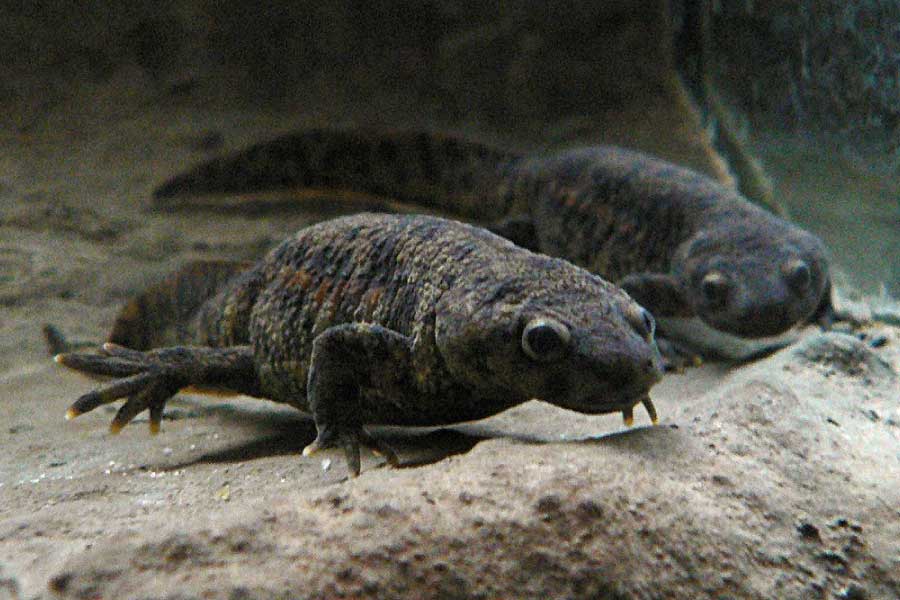
- Scientific name: Pleurodeles waltl
- Type of animal: Amphibian
- Conservation status: Near Threatened
The Iberian ribbed newt is the largest newt found in Europe, but that’s not why it’s on this list of scary animals. We’ve included this terrifying amphibian because of the unique way in which it defends itself from predators.
When threatened, the Iberian ribbed newt is able to puncture its own skin with its sharp ribs. While doing so it also secretes poison from its skin, meaning that an animal picking up the newt in its mouth would get a mouthful of sharp, poisonous spines.
You may think that piercing its own skin with its bones would cause the Iberian ribbed newt serious harm, but in fact the skin quickly grows back, leaving the amphibian seemingly unaffected.
Komodo Dragon
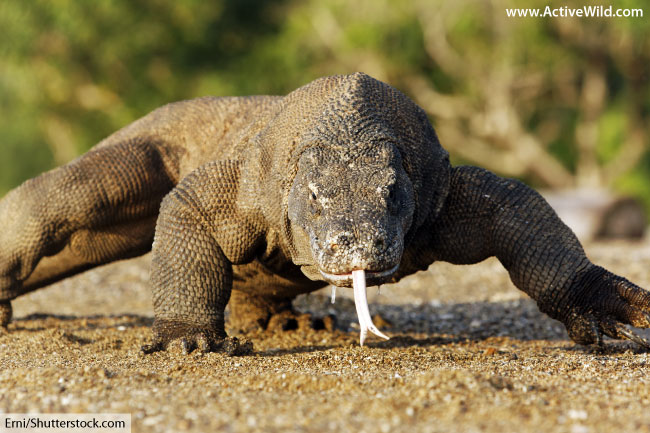
- Scientific name: Varanus komodoensis
- Type of animal: Reptile
- Conservation status: Endangered
Growing to 3 meters (10 ft.) in length, the Komodo dragon is the world’s largest lizard. This Asian species is found on the Indonesian island of Komodo, from which it gets its name, and two other neighboring islands.
With its lumbering gait, the fearsome Southeast Asian lizard would at first glance seem unable to catch nimble-footed prey. Don’t be fooled; the Komodo dragon is capable of a surprising burst of speed. The species is also thought to produce venom that makes its bite even more potent.
- You can find out more about the Komodo dragon on this page: Komodo Dragon Facts
Owls
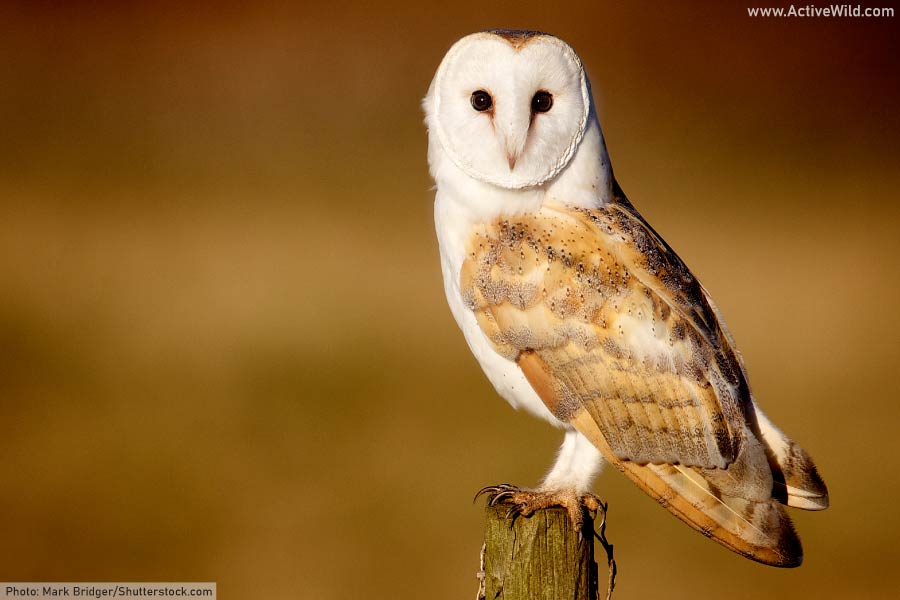
- Type of Animal: Bird
Owls are birds in the order Strigiformes (an “order” is a group of related animals).
Nearly all owls are nocturnal; their large eyes are an adaptation for seeing at night.
Owls also have excellent hearing; the stiff feathers that surround their round faces help to direct sound towards their ears. In addition, special feathers help owls to fly silently.
Because owls are active at night they are often associated with the supernatural. You’ve probably seen a film or TV show that uses an owl’s cry to set the atmosphere for a spooky nighttime scene.
Instead of a pleasant ‘twit-twoo!’, a barn owl (see picture) emits a bloodcurdling range of screeches and hisses. In some areas it is known as a ‘screech owl’ on behalf of its terrifying call.
In addition, the silent, ghostly form of a barn owl flying through the night has led to superstitious people giving it names such as ‘demon owl’, ’death owl’ and ’ghost owl’.
- You can see more owls on this page: Types Of Owls
- You can find out more about birds on this page: Birds: The Ultimate Guide
Pacific Viperfish
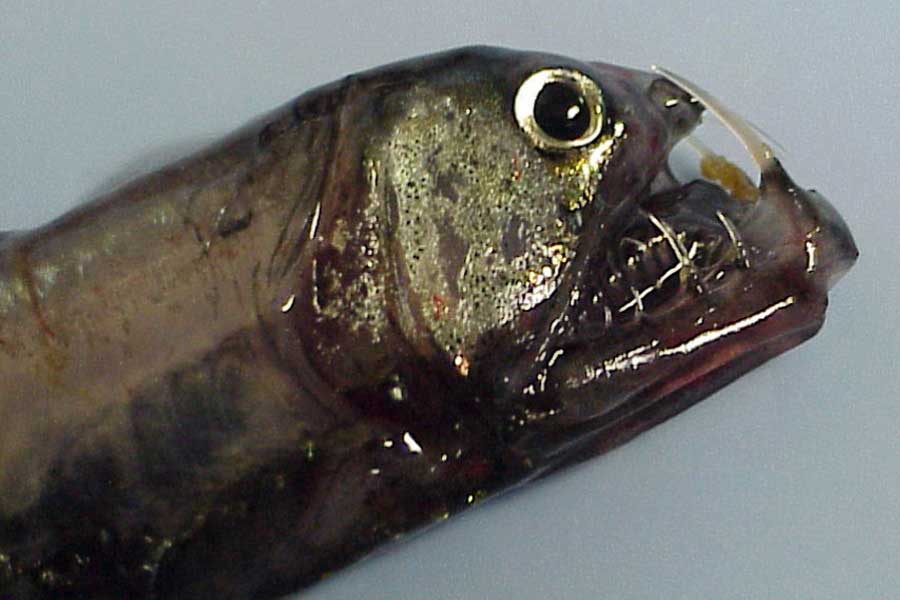
- Scientific name: Chauliodus macouni
- Type of animal: Fish
- Conservation status: Unassessed
The Pacific viperfish is a deep sea fish found up to 5km below the surface. Despite only having a maximum body length of around 30 cm (1 ft.), the Pacific viperfish’s immense fangs are enough to put anyone off going into the water!
Scorpions
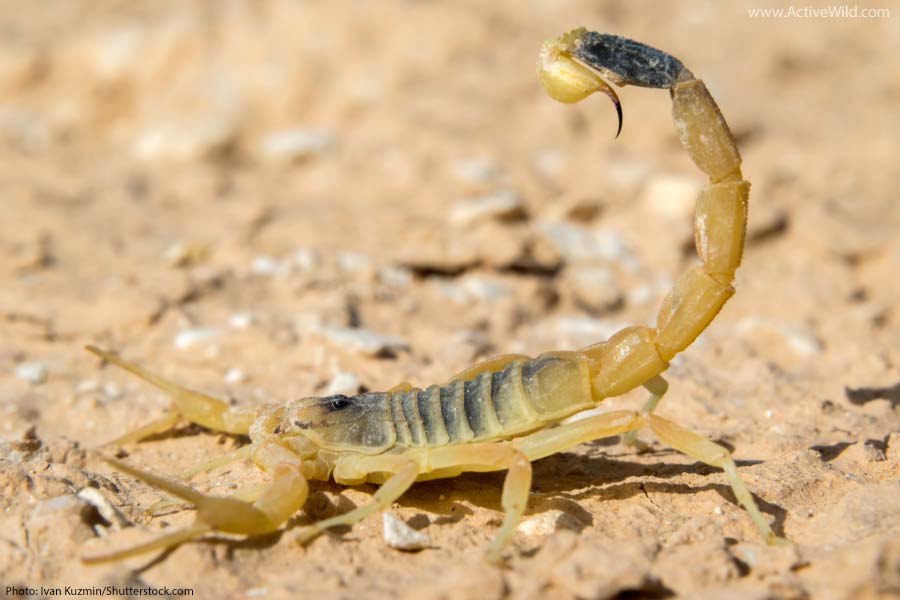
Like spiders, scorpions are arachnids. There are around 1,750 species of scorpion. Together they make up the order Scorpiones.
Whereas some spiders have a venomous bite, it’s a scorpion’s tail you need to be careful of. All scorpions have a venomous stinger located at the end of the tail. This is used both to capture prey and as a defense against predators.
Very few scorpions possess venom strong enough to be deadly to humans. Unless you suffer from specific allergies and no medical help is available, you’ll generally survive a scorpion sting.
The deathstalker scorpion Leiurus quinquestriatus inhabits deserts and other dry habitats in North Africa and the Middle East. Its powerful venom and speedy strike make it one of the world’s most dangerous scorpions.
- You can find out more about scorpions on this page: Scorpions: The Ultimate Guide
- You can find out more about the deathstalker scorpion on this page: Deathstalker Scorpion Facts
- You can find out more about arachnids on this page: Arachnids: The Ultimate Guide
Sharks

“You’re gonna need a bigger boat!” These are the words famously spoken by Roy Scheider’s character Chief Brody after seeing the huge killer shark in the movie Jaws.
Even before the release of classic seventies movie, sharks were regarded as truly terrifying animals; the film just took fear of sharks mainstream.
One of the largest sharks (and the star of Jaws) is the great white shark Carcharodon carcharias. This fearsome ocean predator can reach lengths of 20 ft (6 m).
All sharks are equipped with special sense organs known as ampullae of Lorenzini. These enable a shark to detect electrical fields produced by the muscles of other animals.
Sharks have several rows of teeth. These are continuously replaced during a shark’s lifetime, with new teeth moving from the back to the front. There’s little chance of a shark missing a meal due to toothache!
If you’re in the water and you see a great white shark approaching, it’s a good idea to get in a boat. A big boat.
- You can find out more about sharks on this page: Fun Facts on Sharks
- You can find out more about the great white shark on this page: Great White Shark Facts
Slugs

It’s probably because we’re mammals ourselves that we can relate to other mammals such as cats and dogs better than we can to animals such as slugs.
… Or maybe it’s a slug’s slimy skin, tentacles and sticky trails that puts us off!
Slugs belong to the mollusk class Gastropoda, which also includes snails. Although slugs don’t have visible shells, most species have a much-reduced shell located under their skin.
A slug’s slimy skin prevents its body–which is made mainly of water–from drying out.
Most slugs have two pairs of tentacles, both of which are retractable. A slug’s eyes are located at the ends of the top pair of tentacles. The lower tentacles provide a sense of smell.
- You can see examples of other types of mollusk on this page: Examples of Mollusks
Snakes
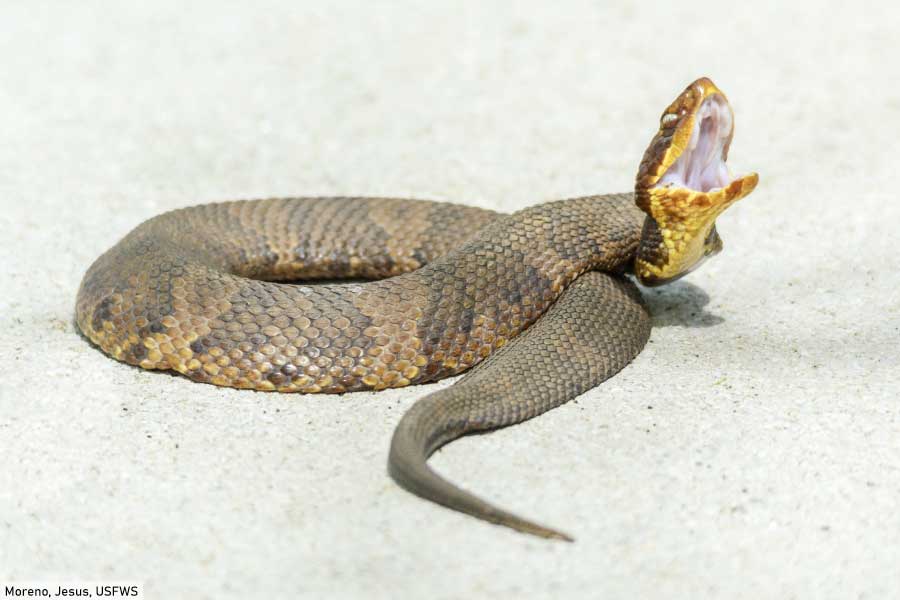
Snakes are limbless reptiles in the suborder Serpentes. Their closest relatives are lizards. Both snakes and lizards are members of the reptilian order Squamata.
The first snakes appeared during the Late Cretaceous period; perhaps 30 or 40 million years before the first primates.
The fear of snakes is known as Ophidiophobia. Scientific research has found that an instinctive fear of snakes may actually be something we’re born with. In other words, snakes are scientifically proven to be scary animals!
There are around 3,600 species of snake divided between 18 families.
The snake family with the largest number of species is Colubridae. Snakes in this family are generally quite small and non-venomous.
The largest snakes are found in the families Boidae (the boa family) and Pythonidae (the python family). Snakes in these families are nonvenomous and use constriction to overcome their prey.
Well known families of venomous snakes include Viperidae (the vipers) and Elapidae, which includes Cobras, mambas and taipans.
- You can find out more about snakes on this page: Fun Facts on Snakes
Spiders
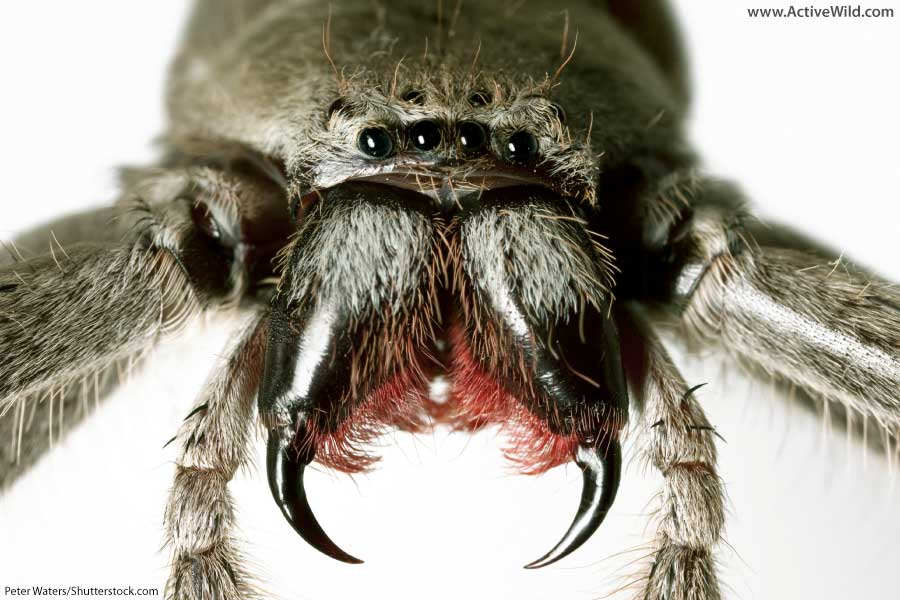
Spiders are arachnids belonging to the order Araneae. With over 48,000 known species, Araneae is the largest order of arachnids.
Not only are there an awful lot of different spiders, they’re also found in virtually all land habitats, and on every continent except Antarctica. That’s bad news if you happen to suffer from arachnophobia! (Arachnophobia is the fear of spiders.)
If you are an arachnophobe, you should probably stay away from these guys:
Redknee tarantula Brachypelma hamorii (a large, hairy spider found in Mexico)
Sydney funnel-web spider Atrax robustus, (a highly-venomous spider found around Sydney, Australia)
Brazilian wandering spider (a large South American species that competes with the Sydney funnel-web spider for title of ‘most venomous spider’)
Redback spider Latrodectus hasselti (another highly-venomous Australian species, recognizable by the red hourglass marking on its otherwise all black abdomen).
- Discover different types of spiders on this page: Types Of Spiders
- You can find out more about arachnids on this page: Arachnids: The Ultimate Guide
Tasmanian Devil
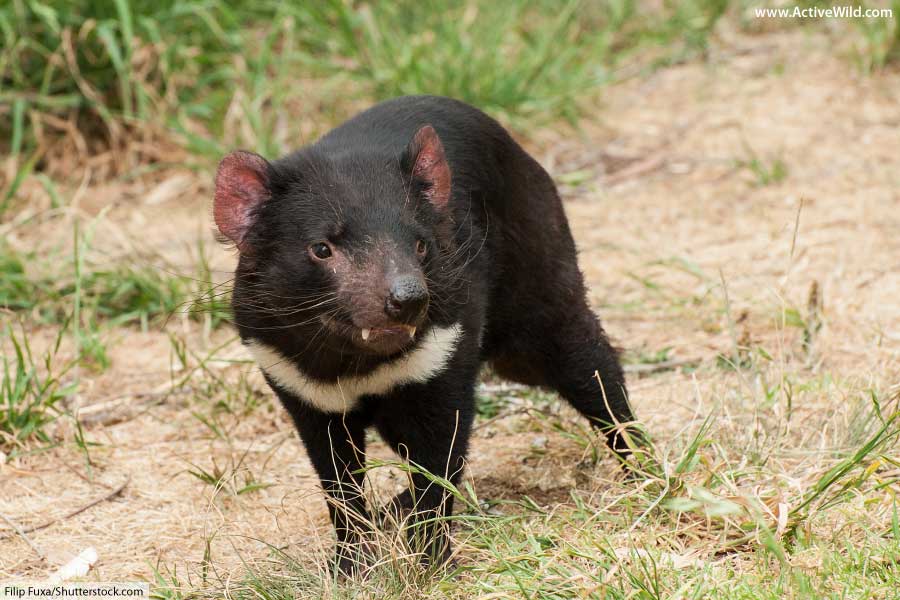
- Scientific name: Sarcophilus harrisii
- Type of animal: Mammal
- Conservation status: Endangered
The Tasmanian devil is the largest living carnivorous marsupial. The size of a small dog, this Australian mammal has a powerful, squat build and large head. It has one of the strongest bites in relation to body size of any animal.
The species is only found on the Australian island state of Tasmania. The ‘devil’ part of its name refers both to the bloodcurdling screams emitted by this nocturnal animal as it feeds, and its aggressive temperament.
Sadly, in recent years this distinctive animal has been badly affected by a disease that has caused its population to plummet. This scary animal now finds itself on the endangered list.
- You can find out more about the Tasmanian devil on this page: Tasmanian Devil Facts
Thorny Devil
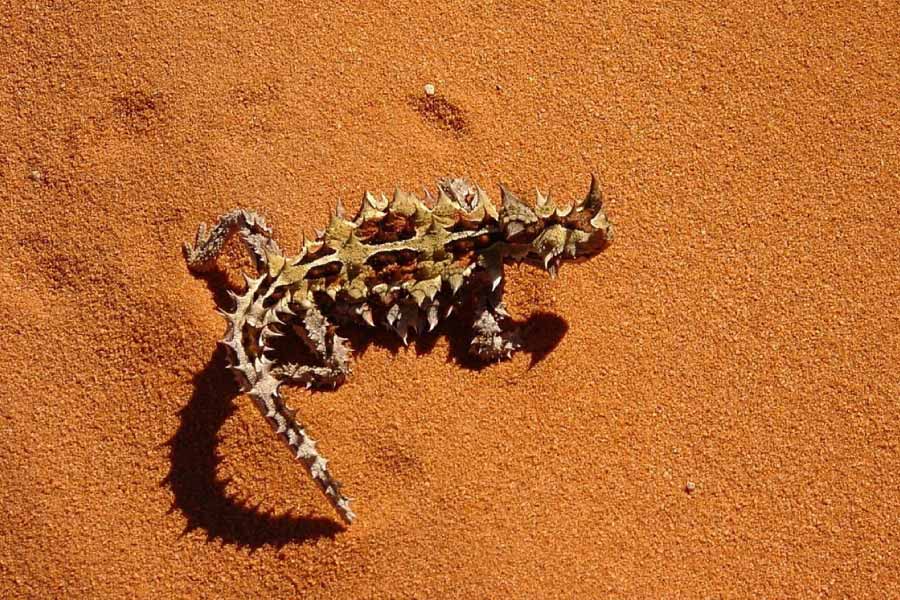
- Scientific name: Moloch horridus
- Type of animal: Reptile
- Conservation status: Least Concern
The ‘Moloch’ part of the thorny devil’s scientific name refers to an ancient god whose followers took part in human sacrifice. The ‘horridus’ part means, well, horrible.
The thorny devil’s scary name is due to the lizard’s fearsome appearance. With horn-like scales on its head and spines running along its back, tail and legs, this desert reptile resembles a mini dinosaur.
A ‘false head’ behind the lizard’s real head–which provides protection from predators–only adds to the animal’s bizarre appearance.
In fact, the thorny devil is well-adapted to the hot, dry climate of the Australian outback. Tiny channels between the scales carry water that has condensed on the animal’s skin to its mouth.
- You can find out more about the thorny devil on this page: Thorny Devil Facts
Toads
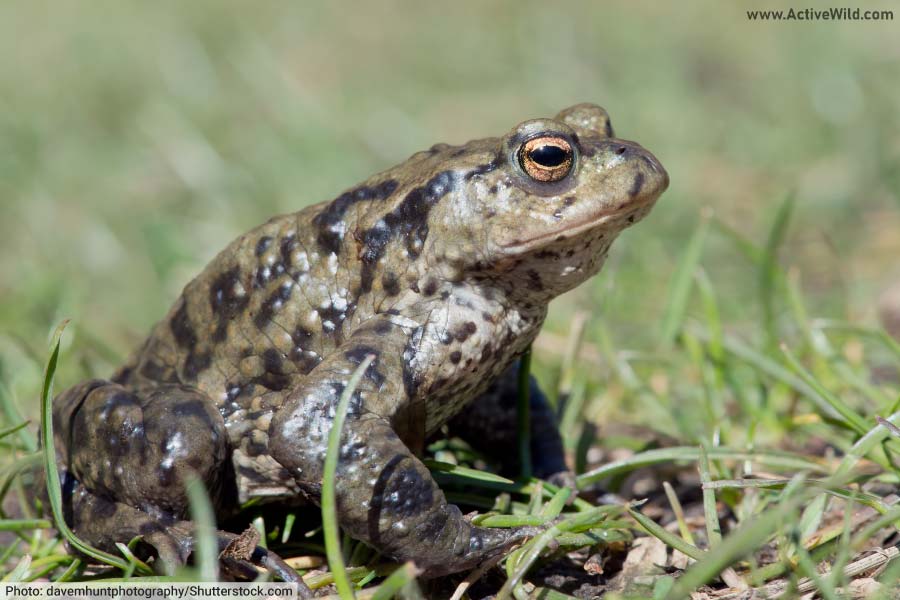
- Type of Animal: Amphibian
- Order: Anura
Toads are amphibians and, along with frogs, belong to the order Anura.
Biologically, there isn’t a great deal of difference between frogs and toads; species with dry, warty skin tend to be named “toads”; whereas species with smooth, moist skin are known as “frogs”.
Toads are included on this list of scary animals due to their association with witches and witchcraft. No self-respecting witch makes a potion without at least one toad in the recipe.
This association may have begun due to the fact that toads in the “true toad” family Bufonidae secrete poison from parotoid glands behind their eyes.
Being amphibians, toads hatch from eggs laid in water, and spend the first stage of their lives as tadpoles. Their bodies then undergo a process known as metamorphosis. During this time toads develop lungs and limbs. In their adult form, toads breathe air and are able to leave the water.
Perhaps the scariest toad of all is the cane toad, a species native to South America. This insect-eating amphibian was introduced to Australia to protect crops.
The plan backfired. The cane toad failed to control crop-eating insects, and its introduction was extremely harmful to several much-loved Australian species, including quolls and goannas.
- You can find out more about amphibians on this page: Amphibians: The Ultimate Guide
- You can find out more about the cane toad on this page: Cane Toad Facts
Vampire Bat

- Scientific name: Desmodus rotundus
- Type of animal: Mammal
- Conservation status: Least Concern
The common vampire bat is one of three species of vampire bat (the other two are the hairy-legged vampire bat, and the white-winged vampire bat). The diet of all three species consists entirely of blood.
The common vampire bat targets mammals–usually livestock–while they are sleeping. It either swoops down directly onto the animal, or lands nearby and crawls over before jumping onto its victim.
Using special heat sensors in its nose, the vampire bat is able to locate where its victim’s blood is flowing closest to the skin. It bites through the skin with razor-sharp teeth, while chemicals in its saliva prevent a scab from forming as it feeds.
Although the vampire bat’s bite is non-fatal, the species is known to carry rabies.
- You can find out more about the vampire bat on this page: Vampire Bat facts
Vampire Squid
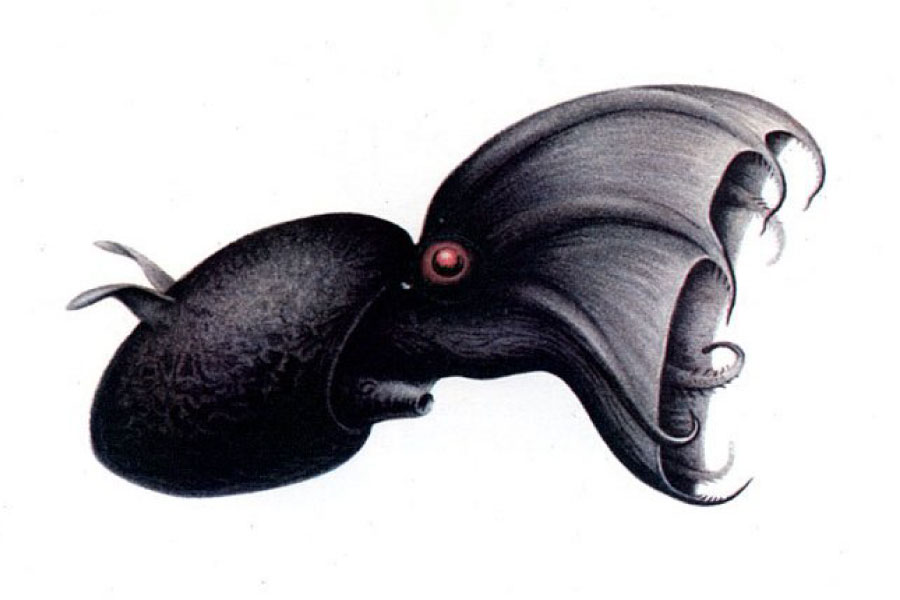
- Scientific name: Vampyroteuthis infernalis
- Type of animal: Mollusk (spelt Mollusc in British English)
- Conservation status: Unassessed
The vampire squid, despite its name, is not a true squid. Instead, it is the only living member of the order Vampyromorphida, and is more closely-related to octopuses.
This deep sea species lives in depths of 3km or more. If threatened, it will open its webbed legs and expose fearsome-looking (but harmless) spines.
This scary animal has got an equally scary scientific name, Vampyroteuthis infernalis, which means ‘vampire squid from hell’.
This scary animal’s scientific name, Vampyroteuthis infernalis, means ‘vampire squid from hell’, which to us sounds like a good name for a heavy metal band.
Wolf
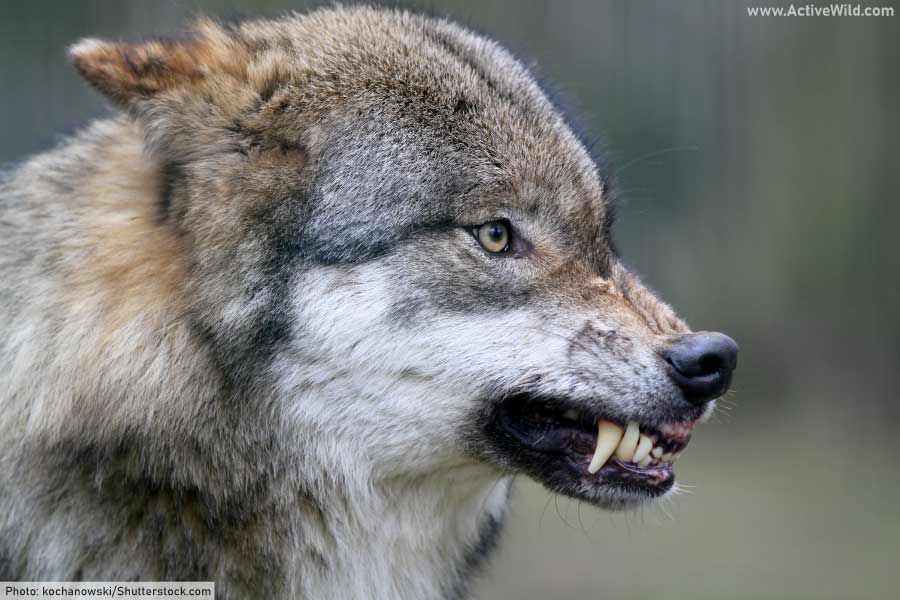
- Scientific name: Canis lupus
- Type of animal: Mammal
- Conservation status: Least Concern
Few, if any, animals have inspired as many myths and legends as the gray wolf. It is an animal of the wilderness which, unlike its cousin the coyote, doesn’t live happily near humans.
The gray wolf is the largest member of the dog family, Canidae. It is found throughout much of the northern hemisphere, and has many subspecies, including the Eurasian wolf, Arctic wolf, northwestern wolf and the domestic dog.
The long, eerie howls produced by a pack of wolves are among the most spine-chilling of all animal sounds.
- You can find out more about the gray wolf on this page: Gray Wolf Facts
- You can find out more about the Eurasian wolf (a subspecies of gray wolf) here: Eurasian Wolf Facts
- You can see every member of the dog family here: Dog Species List with Pictures & Information
Scary Animals: Conclusion
We hope that you enjoyed reading about the scary animals on this page and weren’t too freaked out by them!
You can discover many more amazing animals on the following pages:

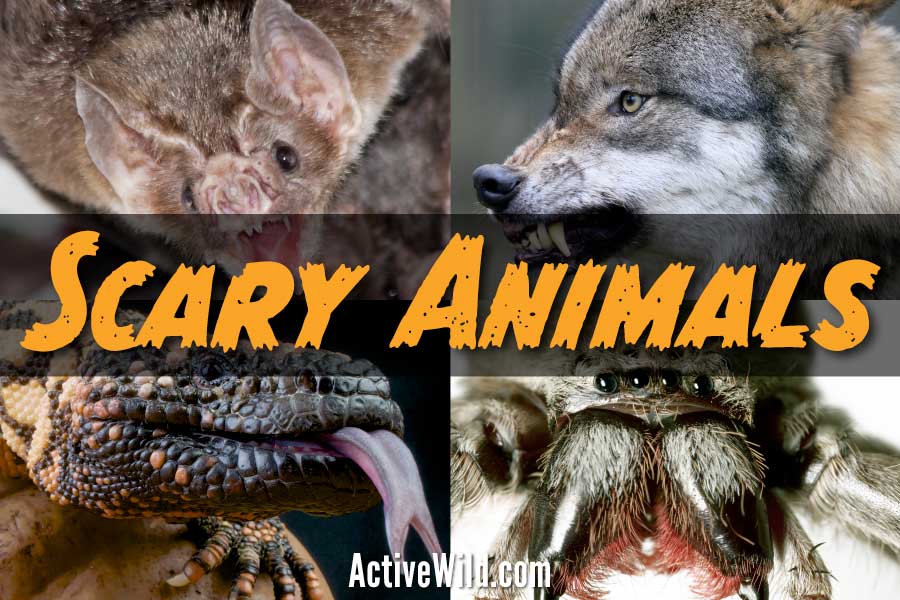

I agree. Wolves are great, and I think just about any kind of monkey is creepy.
Wolves are best!
the bald monkey is freaky